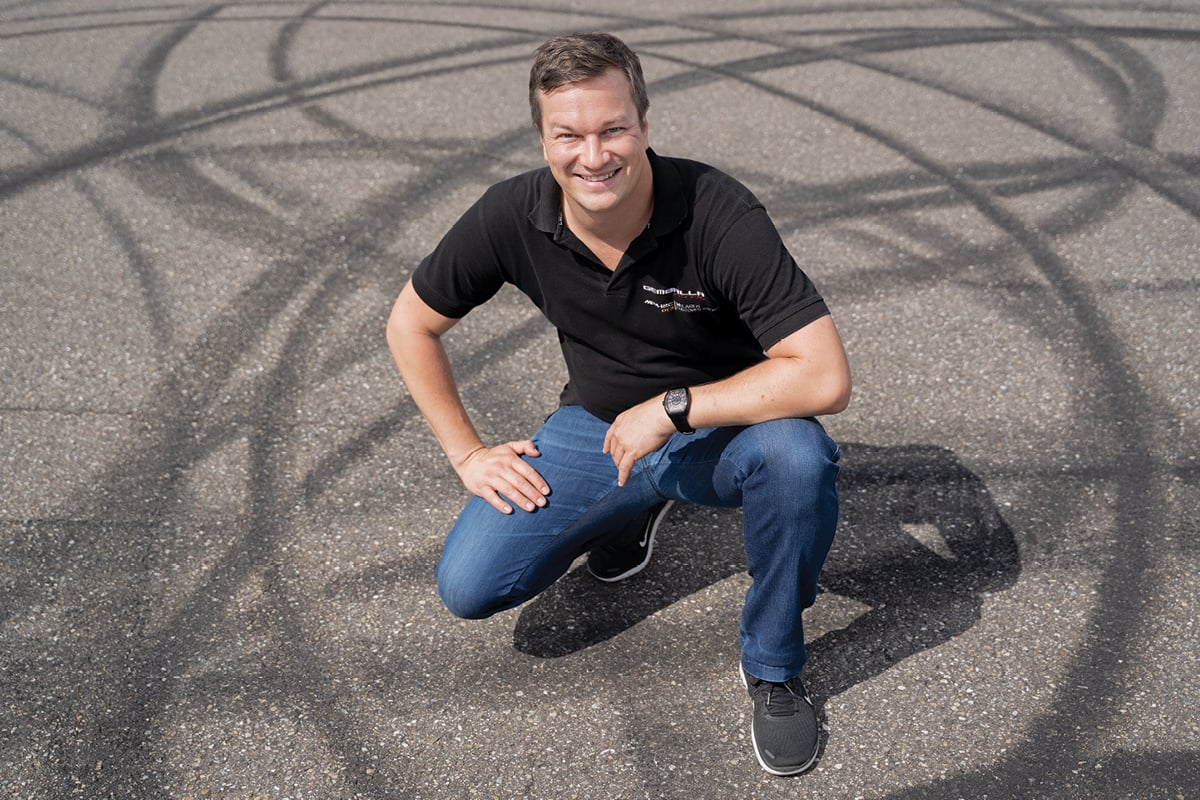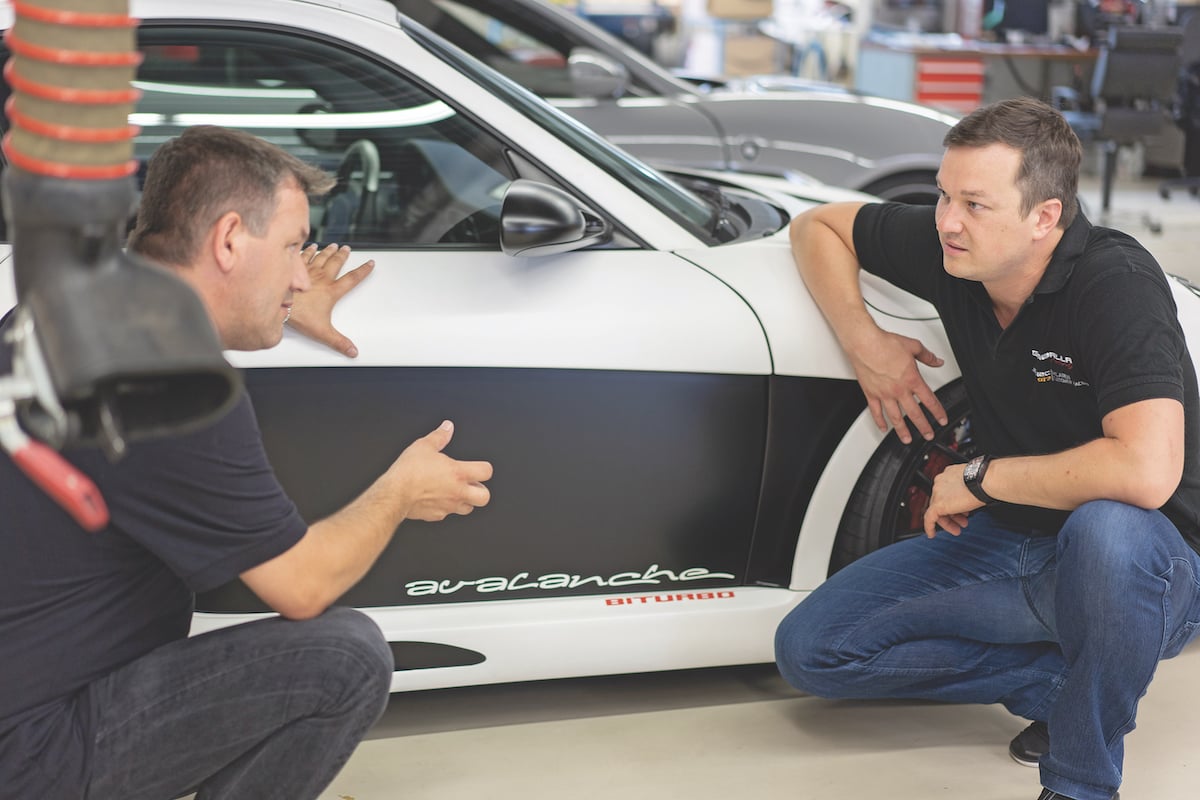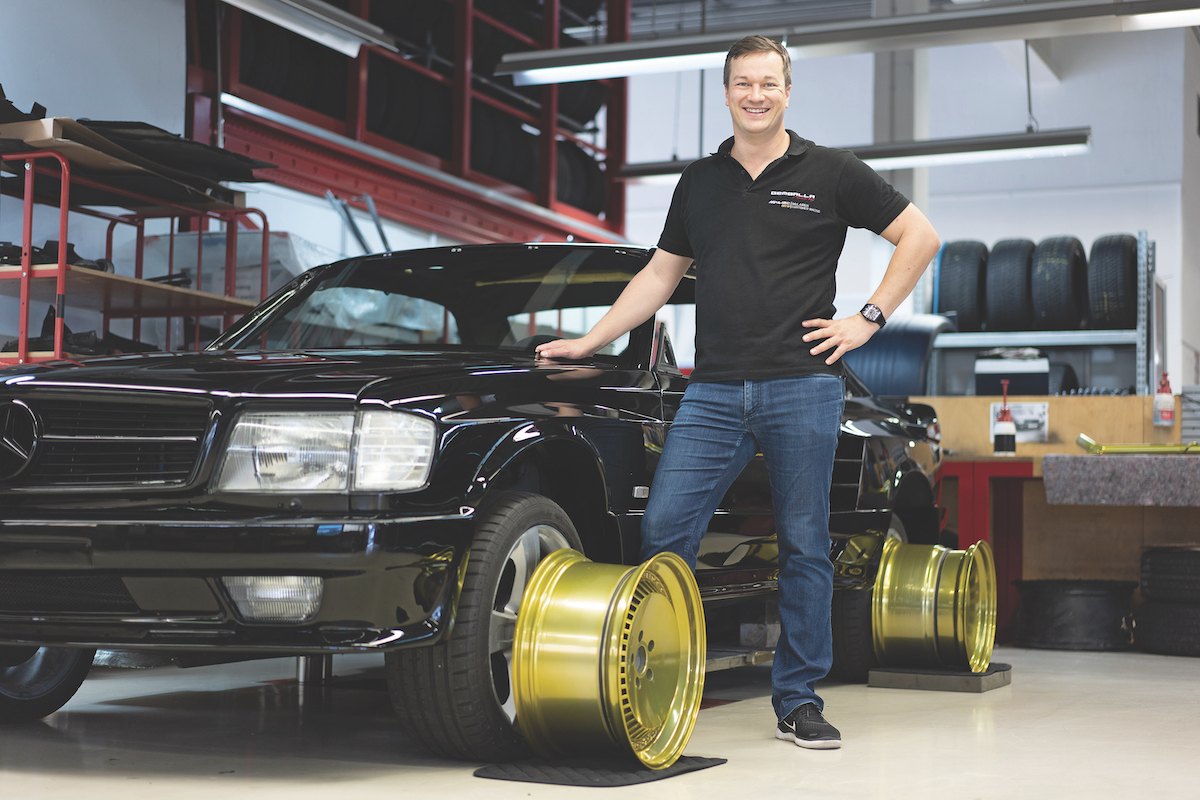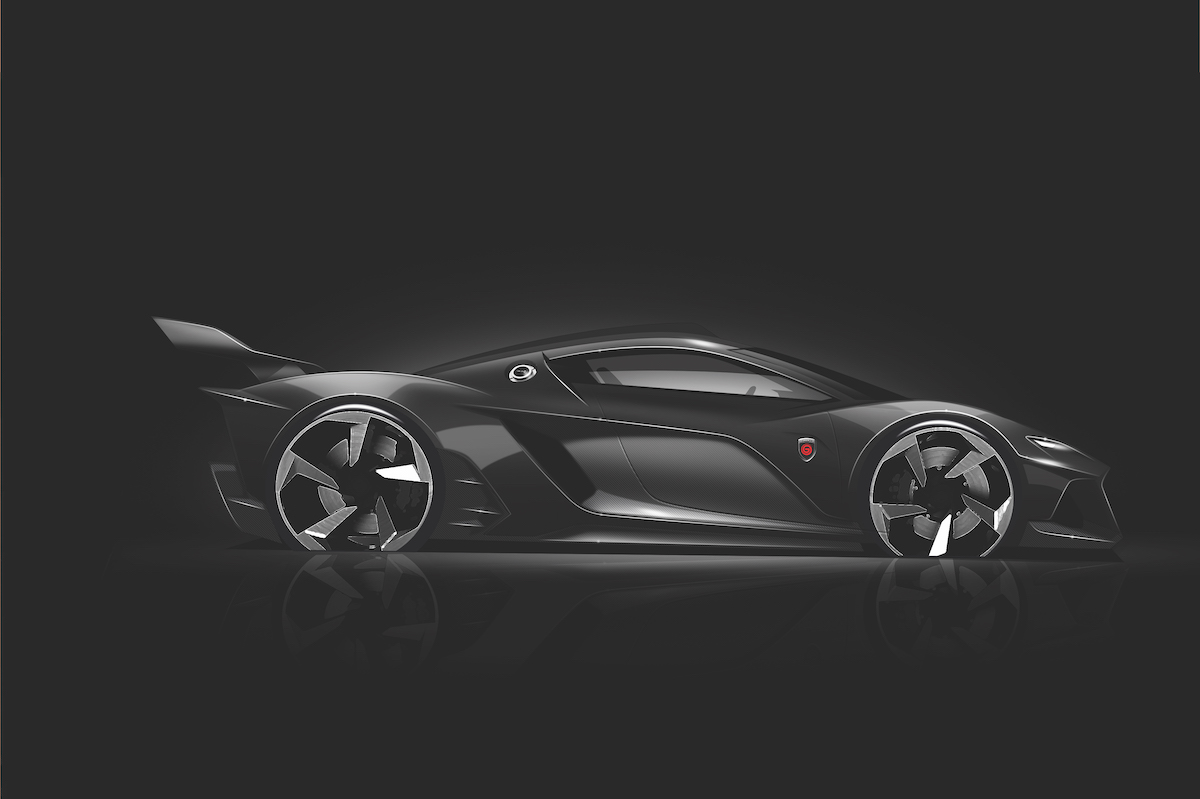Steffen Korbach is on a quest to build a supercar like no other. “We can make a product the mainstream wants, or we can set trends,” he says boldly. Given that GEMBALLA, which is 100% owned by Steffen, is currently raising €20 million to pour into this project, one fervently hopes, for Steffen’s sake, that it’s a trend that will catch on.

Steffen himself is not worried. “What does the customer know?” he asks. “And what does the customer really want? Sometimes, you have to show the customer what is possible to trigger new ideas in them and make them want it.”
To move within the exclusive circle of supercar owners is to be used to a certain swagger – a quality Steffen has cultivated since he was a boy gazing dreamily at the car posters he had stuck on the walls of his room.
By the time he was at university, he had amassed an entire fleet of model cars and a couple of real ones in his garage. Yet, he wasn’t satisfied. “I wanted to start my own company to build my own supercar,” he recalls.
Then, in February 2010, news came that Uwe Gemballa, founder of the eponymous company best known for making outrageous modifications to Porsche cars, had gone missing in South Africa, and was later found dead.
When a well-connected friend offered Steffen the possibility of taking over the company, he jumped at the chance – never mind that the circumstances surrounding Uwe’s
death were mysterious and tainted with sordid possibilities of underworld dealings.
“We can make a product the mainstream wants, or we can set trends.”
Since he bought the company, Steffen has spent the past nine years focusing on GEMBALLA’s core business, which is car tuning, putting the dream of building his own car on the backburner. But far from being forgotten, the dream has simply been transformed. “Now, my vision is to create a small series GEMBALLA car,” he reveals.
Steffen’s confidence that such a product will be well-received is not entirely misplaced. On paper, GEMBALLA is a car tuning company. In practice, the term greatly underrates the scale of modifications that the firm takes on.

“I think the word ‘tuning’ gives the wrong impression of what our business is about. When people talk about tuning, they think about minor modifications like putting different wheels on the car, or making it a little wider,” says Steffen.
“I don’t see GEMBALLA as a tuning company. Unlike in English, where manufacturer implies mass production, in German it means a small-scale artisanal studio that builds exclusive products.”
An extreme modification by GEMBALLA may take anywhere between three and six months to complete. It usually involves stripping the car down to its basic frame and rebuilding the entire body from scratch – it is as close as anyone could get to building a car without actually doing so.
Steffen illustrates the process with the GEMBALLA Tornado, based on the Porsche 958 Cayenne, as an example: “The entire body of the original car has been removed and replaced with one of high-quality German-made carbon fibre. The doors have also been replaced by carbon fibre ones built in GEMBALLA’s own facility.”
As testament to its expertise, GEMBALLA has been a registered car manufacturer in Germany since 1985. Now, it’s just a matter of putting this licence to good use in order to realise Steffen’s supercar dream.
“Just 10 years ago the supercar/hypercar market was small. There were a few specialised companies such as Pagani and Koenigsegg. Then, Bugatti introduced the Veyron, the first car priced at €1 million,” says Steffen. “This established the acceptance among collectors of million-dollar automobiles.
“GEMBALLA, too, had a few cars that sold in the 80s for US$1 million (€888,000). They were probably some of the most expensive cars at that time. It was famous in the 80s and 90s for doing things that no-one had done before. That’s why I think it is the right company to produce a hypercar.”

As of now, GEMBALLA is a boutique brand that does not have the scale of better-known names such as Bugatti, Ferrari or Porsche. But Steffen believes that the firm’s small size is a strength, not a weakness.
“Large organisations have many people involved in decision-making and design,” he points out. “This means that they face many restrictions in what they do. Everything has to comply with the brand story.
“Of course, the brand story is also important to GEMBALLA, but because I am the owner as well as the CEO, and because we are a smaller company, we have freedom that large companies do not have. We can do what we want; we can do things that may be considered too extreme for the bigger brands. There’s a big chance that we can stand out.”
“We can do what we want; we can do things that may be considered too extreme for the bigger brands. There’s a big chance that we can stand out.”
At the time of writing, GEMBALLA had just released a teaser photo of the first small series supercar that’s in the works. According to the single digitally-rendered image, which shows only the side profile of the vehicle, it is going to be a sleek, all-black beast that calls to mind the Batmobile. Technical details are scant, although Steffen did mention that the firm is aiming for more than 800bhp.
“We want to do something that is not mainstream, but it should not be forced. It should be typically GEMBALLA,” Steffen says. “We are taking some inspiration from the design features of old-school cars from the 80s and 90s and also incorporating something extreme in its aesthetic.”
To accommodate Steffen’s big dreams, the company has plans to build a new production facility that is spacious enough to house both segments of the business. “GEMBALLA will definitely continue with its core business of extreme modifications,” Steffen confirms. “The small series production is just an additional segment of business for the company.”
This is good news for faithful customers of GEMBALLA’s modified vehicles, who love the brand for the extraordinary customisations it can provide. “Many people, when they buy a standard car – such as a Porsche, for example – go on a configurator on the website to choose from maybe 20 different combinations of interior colours,” says Steffen. “But there are many customers who want something different that is not being offered and this is where GEMBALLA comes in.”
He shares a particularly memorable order the firm took on: “One of the most famous cars we have built is the GEMBALLA Extremo, based on the Porsche 911. It was originally built as a promotional vehicle for Fulda, a tyre manufacturer in Germany and then shown in Dubai. It caught the eye of a member of the Saudi royal family, but the car was not for sale as it was only a show car. We had to immediately build a second car for him after he offered us US$1 million (€888,000).”
A drive through Gemballa’s history
1979 – Uwe started working on interior modifications for BMW and Porsche cars, installing cutting-edge audio and video equipment as well as other electronic instruments. He also offered leather retrims.
1981 – As business started to pick up, Uwe officially registered the GEMBALLA company name. This was also the year the company undertook its first extreme modifications, including the production of a slant-nose design for the Porsche 911.
1983 – GEMBALLA pioneered remote control functions for theaudio system into the steering wheel, a revolutionary development for its time.
1985 – This was the year the GEMBALLA name truly started carrying clout. The company gained attention worldwide among car enthusiasts with the debut of GEMBALLA Avalanche and convertible GEMBALLA Cyrrus, based on the Porsche 911 and 930.
1986 – GEMBALLA pioneered the use of rearward facing cameras linked to a TV screen in the car. The company had once again come up with a development that was ahead of its time.
1989 – Gemballa developed the first aerodynamic and technology programmes for the Porsche 964 and 965, modifying not just the physical appearance of these cars, but also their performance.
1994 – The firm developed its first twin-turbo engine conversion.
1996 – GEMBALLA unveiled the GEMBALLA Extremo, the promotional car for tyre maker Fulda, that caught the eye of a member of the Saudi Royal family. The royal paid the company US$1 million (€800,000) to produce a second version of the car.
1998 – The company moved its premises to Mollenbach Strasse 17 in Leonberg, Germany.
2002 – The GEMBALLA GTR 600-R, which was based on the Porsche 996 GT3 and had a 600hp engine, broke records at the Nürburgring Nordschleife race for street-legal vehicles. It also won accolades at the Sport Auto Tuner Grand Prix at Hockenheim.
2006 – The limited-edition Mirage GT was unveiled to great fanfare. It was not hard to understand why. Based on the Porsche Carrera GT, the car had 670hp with 630Nm of torque and a V10 engine that gave it a top speed of 335km/h.
2009 – The MIG-U1 was unveiled. Limited to five cars, GEMBALLA built only one of this car, making it ultra-exclusive. Based on the Ferrari Enzo, it shaved 35kg off from the vehicle’s total weight due to the extensive use of carbon fibre and had a 700hp V12 engine that enabled it to go up to 355km/h.
2010 – Steffen Korbach bought GEMBALLA after the death of Uwe Gemballa. Steffen has since invested over €15 million in the company and became CEO in 2015.
2011 – GEMBALLA celebrated its 30th anniversary and marked it by unveiling the Tornado, based on the Porsche Cayenne Turbo, and the Mistrale, based on the Porsche Panamera. Both models featured carbon fibre body panels that significantly reduced the weight of the original vehicles and produced a capability of far over 700 bhp.
2013 – The company released the Aero III, the latest version of the Aero, which is based on the Porsche Cayenne 958, the GT and the GT Spider, which are themselves based on the McLaren MP4-12C.
In addition to small series production and extreme tuning, Steffen is also looking to expand GEMBALLA’s services to include restoration for older or vintage vehicles. “Increasingly, we are getting collectors who approach us with rare cars from the 80s or 90s that they want refurbished,” he says.
Appealing to royalty and long-time fans is all very well, but Steffen is aware that the future of the company lies with the next generation of car collectors. Under the charismatic leadership of Uwe Gemballa, the brand enjoyed its peak in the 80s and 90s but started to see a drop-off in profits by the 2000s.
In fact, it was believed that Uwe’s fatal trip to South Africa was to meet with an investor to get funds for the business. Steffen needs to re-establish the clout Uwe brought to the brand among young car collectors – an uphill task, given that most of them were only children when the brand was at its peak and have likely never heard of Uwe before his passing.

In addition, the competition has only become tougher with the passing of the years. “Back in the 80s and 90s, the market wasn’t saturated with so many companies and products,” he says. “And not many firms had the capacity to perform extreme modifications to cars. Today, with the possibilities of production offered by carbon fibre, smaller companies are able to move into the tuning business with much smaller investments.”
Preferences have also changed. “Among the older generation, those who chose to tune their cars did it to stand out and make a statement. They were very much into extreme designs,” says Steffen. “Today’s generation prefer to buy into trends. They have a fear of being too different.”
But Steffen remains undeterred by the pressure of what other businesses are doing, reiterating what he said earlier about GEMBALLA being a trendsetter that creates new wants and desires among collectors. Being a visionary is, after all, what the brand has always been about.
“We have very big shoes to fill because Uwe was one of the pioneers of the tuning business. I’ve heard people say that GEMBALLA’s no longer the same anymore without him,” Steffen laments. “The challenge for me is to continue his legacy and gain recognition as his successor.”
But before he realises this goal – or the production of a GEMBALLA supercar – Steffen can always turn to his favourite automobile: the Bugatti Veyron Sang Noir. “It’s my favourite because of what it represents. It was the first supercar by a large manufacturer, the first car to be priced at €1 million, and the first car with a top speed of 400km/h. I think it is completely underrated and is a car I would never sell.”
Perhaps the Bugatti Veyron Sang Noir is also the model of success Steffen wants GEMBALLA’s first supercar to be. Here’s to hoping that it matches up.


